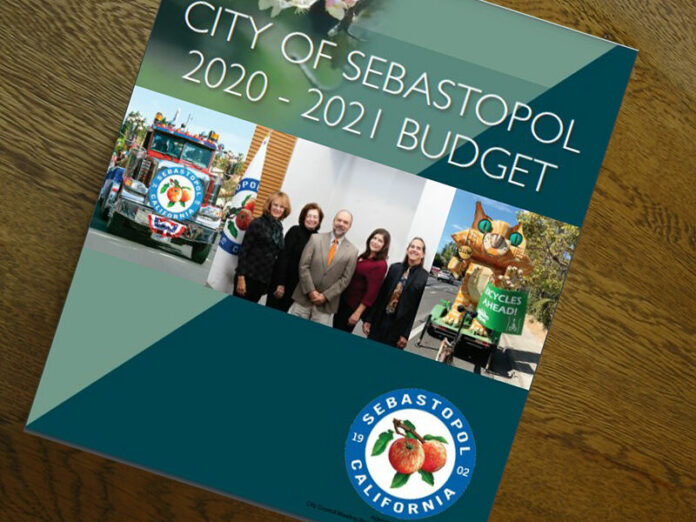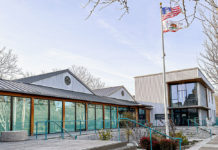The city of Sebastopol approved the adoption of the 2020-21 budget at the Oct. 20 Sebastopol City Council meeting. Last week, on Oct. 14, an entire special meeting of the council was devoted to a consideration of a budget.
Council members noted that it seemed odd to be adopting a budget three months into the fiscal year, but back in June the council adopted a placeholder budget because of the uncertainties of the pandemic.
Before the approval, the council members on the budget committee — Una Glass and Neysa Hinton — have met with the heads of each city department and gone over the budget with a fine tooth comb, looking for possible savings to make up for falling revenues caused by the COVID-19 pandemic.
“We always ran really lean as a city, so there wasn’t a lot of fat to cut,” said Hinton.
Sebastopol Budget Director Ana Kwong introduced the budget this way:
“What is the city facing? Obviously, an unbalanced budget,” she said. “Are we running out of cash? Not yet, but we will be if we keep going at the pace we’re going.”
The raw numbers and the reserves
The revised budget figures are as follows:
City revenues, including a general fund transfer of $102,000, are expected to be $8,633,400.
City expenditures are $10,825,445.
That leaves a projected shortfall of $2,081,645, which, after numerous additions and subtractions, was adjusted upward to $2,192,045.
The city will cover this shortfall by withdrawing that amount from its financial reserves.
“We have been really good about putting aside money that we were saving for a rainy day, and luckily we have that,” Hinton said.
This will leave Sebastopol with reserves of 22%, or roughly $2,383,468.
Some uncertainty in the numbers
In discussing the budget, both Kwong and Glass warned that there was some uncertainty about the city’s revenue projections, given the disruptive nature of the pandemic.
“Predicting what’s going to happen is, well, we’re in uncharted territory,” Glass said.
Kwong noted that of the city’s four main revenue sources — sales taxes, hotel taxes, user charges and property taxes — the first three declined sharply. Sales tax revenue from hard-hit businesses declined 18%, compared to 2019, while property tax revenue remained relatively stable, even inching up a bit due to a 2% adjustment for inflation.
Altogether, the city is looking at a loss in revenues of around 20%, or roughly $2.2 million.
Department by department
The cost of running Sebastopol’s city government continues to climb, even as the city’s revenues fall. The cost increases are partially the result of unfunded mandates from the state and federal level, but not always. According to the individual department Budget at a Glance summaries contained in the Final Budget presented at the Oct. 20 city council meeting, the numbers are as follows:
The City Council budget went up 1.4% to $323,945.
The City Manager’s budget went up 20.5% to $556,955, primarily because of payments to the city’s economic vitality contractor, the business loan program, COVID outreach, and election year fees.
The City Clerk’s budget went up 8% to $375,180.
Administrative Services budget went up 2% to $1,061,525.
The Planning Department budget went down 13% to 581,265, because some contracts came to an end.
The Building Department budget went up 12.6% to 307,320, due to the preparation of a local hazard mitigation plan and flood monitoring.
The Engineering Department/Storm Water budget increased by 39.5% to $556,945, primarily because a job in that department was reclassified upwards and because of storm water compliance.
The Fire Department budget increased by 8% to $1,217,094.
The Police Department budget increased by 4.5% to $4,971,415. This is the city’s largest budget item by far. The increase was the result of the police audit, the addition of social services/mental health services (for the public, not the officers), as well as maintenance to vehicles and buildings.
The Public Works budget increased by 6.7% to $1,847,940. This increase was due to facilities maintenance at the fire and police departments and zero waste building modifications at City Hall. Utilities increased due to the council’s decision, pre-COVID, to switch to Sonoma Clean Power’s Evergreen program.
Expenditures for the Senior Center, the Community Center and Ives Pool went down 12.3% to $446,555.
A little bit for everybody
Every year, the Sebastopol City Council also gives out community benefit grants to a large number of nonprofit organizations in the city. Despite the deficit, this year was no exception. Because of the pandemic, the grant requests from local nonprofits were almost two-and-a-half times higher than usual. Bowing to circumstance, however, the council decided to fund the grants at roughly 80% of their 2019-2020 funding levels for a total of $209,990.
The largest recipients included the Chamber of Commerce ($12,000), the Sebastopol Sea Serpents ($11,000), Mr. Music Foundation ($10,000), the Sebastopol Center for the Arts ($9,500), the Ceres Community Project ($8,000), and Gravenstein Health Action ($8,000). The Gravenstein Health Action grant was added after council discussion on Oct. 20.
“These nonprofit organizations benefit us in immeasurable ways,” Mayor Patrick Slayter said. “Because we are a small city, we don’t have a Parks and Rec department, but we have a Community Cultural Center and the Senior Center. (Editor’s Note: these are funded through a different line item). I see Health Action, sort of along the same path; we don’t have a Department of Public Health in the city of Sebastopol — we depend on the county.”
But now, Slayter suggested that Gravenstein Health Action, which got a big wad of funding during the death throes of the Palm Drive Health Care District, could step into a similar role.
Looking forward
Discussions on the broader ramifications of the budget were kept to a minimum at the Oct. 20 meeting, but at the end of the Oct. 14 Special Budget meeting, Glass rung a warning note.
“In summary, we can’t keep going like this,” she said. “I am incredibly happy that we were so thrifty in past years, because we have such a big reserve. We are not in dire straits. I’m sure there must be other cities that are in dire straits. However, we’ve got our reserves now down to 22%. They were around 60% a few years ago. Now a 22% reserve for most cities is considered really good, but if you look at the fact that we’re operating with a $2 million deficit, that’s pretty scary.”
“We don’t know when and how that money is going to come back to us I mean we have to keep thinking about how to develop our tax base and be supportive of our businesses, but it’s hard to see, in the midst of COVID, how that’s going to happen,” she said. “I think the results of what happens in November is actually going to have a really big impact on how much money is available to state and local government for COVID recovery and for economic recovery on a local basis.”
See the complete budget here: https://bit.ly/35k8Q3p. The full Community Benefit Grants list, minus the late addition of Gravenstein Health Action, is on page 40 of the this document (page 47 of the PDF).
Townsy is a recently-launched community app, offering local news, online shopping at local stores, a local event guide, local volunteer and job boards and more.
Sonoma West Publishers is partnering with Townsy to make our news more accessible to the Sebastopol community.








